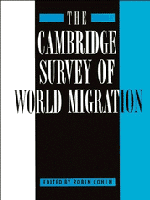Book contents
- Frontmatter
- Contents
- List of illustrations
- List of tables
- Notes on the contributors
- 1 Prologue
- 2 European colonization and settlement
- 3 Asian indentured and colonial migration
- 4 The great Atlantic migration to North America
- 5 Migration in Europe, 1800–1950
- 6 Migration in Africa
- 7 Latin and Central American migration
- 8 Migration to North America after 1945
- 9 Labour migration to western Europe after 1945
- 10 Repatriates and colonial auxiliaries
- 11 Migration in Asia and Oceania
- 12 Migration in the Middle East
- 13 Refugees from political conflict
- 14 Migrants and asylum-seekers in contemporary Europe
- 15 Emerging trends
- Acknowledgements and credits
- Index
15 - Emerging trends
Published online by Cambridge University Press: 05 December 2012
- Frontmatter
- Contents
- List of illustrations
- List of tables
- Notes on the contributors
- 1 Prologue
- 2 European colonization and settlement
- 3 Asian indentured and colonial migration
- 4 The great Atlantic migration to North America
- 5 Migration in Europe, 1800–1950
- 6 Migration in Africa
- 7 Latin and Central American migration
- 8 Migration to North America after 1945
- 9 Labour migration to western Europe after 1945
- 10 Repatriates and colonial auxiliaries
- 11 Migration in Asia and Oceania
- 12 Migration in the Middle East
- 13 Refugees from political conflict
- 14 Migrants and asylum-seekers in contemporary Europe
- 15 Emerging trends
- Acknowledgements and credits
- Index
Summary
The purpose of Part 15 is threefold: first, to draw attention to new forms and patterns of world migration; second, to cover aspects of migration that gained only passing expression in the previous Parts of the Surveys and, finally, to assess the significance of global migration flows from ethical and political standpoints.
Often, of course, new forms of migration turn out to be older forms in fresh disguise. Thus it is with contract-labour migration, which Castles succinctly defines as ‘temporary international movements of workers, which are organized and regulated by governments, employers or both’. As he notes, such migration has plenty of precedents – from the Asian indentured labour described in Part 2, the ‘foreign Poles’ who were recruited for industrial work in nineteenth-century Germany, the mine workers in South Africa and the Bracero Program in the USA, to the western European ‘guest-worker’ system. The intention of the employers and the government was twofold: to avoid any long-term commitment to the contracted migrants (thus allowing hiring and firing to match the economic cycles) and to inhibit settlement (thus reducing social costs and lessening the chance of resentment by the local workforce). These two desiderata still remain for many firms and governments. Source countries are now mainly in Asia (a region that provided nearly 12 million contract workers worldwide in the period 1969–89), though, as Castles shows, the Middle East has now declined in importance as a destination area in the wake of the Gulf War and the growth of demand in the emerging hothouse economies of Asia itself.
- Type
- Chapter
- Information
- The Cambridge Survey of World Migration , pp. 507 - 560Publisher: Cambridge University PressPrint publication year: 1995



